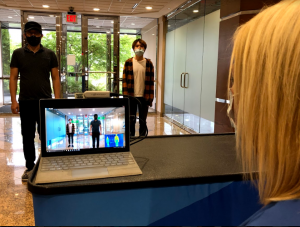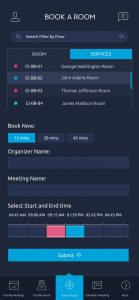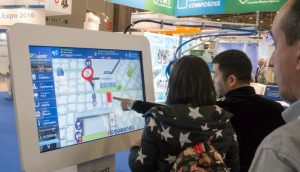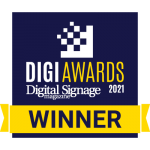Three Technology Features that are Improving the Visitor Experience
New innovations are changing the way business managers approach digital signage, TECHNOLOGY management, and wayfinding to improve visitor experience
Much has changed in the past year as a result of the COVID-19 pandemic. AV/IT managers, systems integrators, and facilities managers alike face a heavy set of expectations as they navigate new opportunities and challenges in supporting the return to normal across enterprise, higher education, retail, healthcare, and other industries. Typical building operations that managers had planned for are now accompanied with new public safety initiatives, and from accommodating the ever-adapting COVID-19 safety regulations to ensuring peace of mind and safety for building occupants, there are many new logistical considerations to be met. Nevertheless, there are also prospects for new innovations in facilities amid the mandated public health shifts: immersive and interactive technology is defining a new standard for safety and interactivity.
Recent advancements in management software introduce new digital signage applications and checkpoints for meeting spaces and facilities to keep safety at the forefront. By upgrading or installing digital signage solutions within a facility, businesses can leverage access control, room scheduling solutions, and interactive wayfinding to regulate and maintain a safe environment.
Let’s take a look at three innovations changing the way business managers approach digital signage, content management and wayfinding to improve the entirety of the visitor experience.
Simplify Technology Management: Start with Access Control
 Companies across industries have been forced to focus their attention to developing solutions for building access points to ensure employee and visitor safety. Access control technologies specifically cultivated to reduce viral spread are offering new, simple ways to control and monitor who is entering. There is a larger focus on hygiene and safety, but efficiency also remains a priority as operations come back to life. Luckily, managers have no shortage of options for leveraging digital content design and displays to share information as the first point of communication.
Companies across industries have been forced to focus their attention to developing solutions for building access points to ensure employee and visitor safety. Access control technologies specifically cultivated to reduce viral spread are offering new, simple ways to control and monitor who is entering. There is a larger focus on hygiene and safety, but efficiency also remains a priority as operations come back to life. Luckily, managers have no shortage of options for leveraging digital content design and displays to share information as the first point of communication.
Check-in kiosks with surveys and questionnaires and virtual receptionists are among the latest access control technology applications. With the right content management software, managers can customize welcome screens positioned at the entrance of facilities to communicate critical public safety information and prompt visitors to complete wellness surveys directly on the screen, or via their mobile device to reduce touch points on public touch screens.
To further reduce touchpoints, many kiosks can be equipped with voice control prompts to allow for instant communication and directions, or even with a virtual receptionist who can safely video chat and provide a secure check-in process via live video stream. The abundance of features available for check-in does not stop there: touch-free check-in and COVID-19 screening, facial and mask recognition, multi-user tracking, and thermal scanning are all becoming widely adopted to reduce viral spread.
Give Scheduling a Facelift
 Moving beyond the initial welcome, the way that venues are inviting guests to arrive at designated spaces has shifted to accommodate safety needs as well, while still prioritizing productivity. Hotdesking and automated room scheduling have taken off and will continue to improve the visitor experience in 2021. Hotdesking combines wayfinding and room booking to highlight room and workspace availability on screen with real-time, color-coded mapping, which allows for more productive movement and fewer touchpoints for visitors throughout a facility. These technologies grant managers the ability to quickly and efficiently adjust or dedicate spaces for work or meetings to meet both public safety and agile work demands.
Moving beyond the initial welcome, the way that venues are inviting guests to arrive at designated spaces has shifted to accommodate safety needs as well, while still prioritizing productivity. Hotdesking and automated room scheduling have taken off and will continue to improve the visitor experience in 2021. Hotdesking combines wayfinding and room booking to highlight room and workspace availability on screen with real-time, color-coded mapping, which allows for more productive movement and fewer touchpoints for visitors throughout a facility. These technologies grant managers the ability to quickly and efficiently adjust or dedicate spaces for work or meetings to meet both public safety and agile work demands.
The hotdesking process is driven by data and returns favorable responses from visitors: This practice can help visitors feel safe about the desk, office, or meeting room they are occupying, with data gleaned from when it was last cleaned, and who the last occupant was for contact-tracing purposes. This floorplan data can help managers support social distancing strategies by providing insight into which floor configurations are working and have real-time access to how employees are navigating within the office space. The ability to evaluate detailed occupancy and building data is invaluable for managers looking to closely monitor safety without sacrificing operations.
Take Control of the Visitor Journey
 Even with access control and hotdesking, visitors still need to get from point A to point B when entering the building. A simple, static sign at the entry is no longer enough to guide guests and keep them engaged. They are also a logistical nightmare to keep updated, particularly in light of evolving needs post-COVID.
Even with access control and hotdesking, visitors still need to get from point A to point B when entering the building. A simple, static sign at the entry is no longer enough to guide guests and keep them engaged. They are also a logistical nightmare to keep updated, particularly in light of evolving needs post-COVID.
Digital wayfinding positioned throughout the building, along with options for voice or mobile control to reduce physical touchpoints, ensure that your guest stays both informed and immersed in an advanced technological experience throughout their visit.
Secure mobile technology is innovating the way managers protect patrons, employees, and more. Venues can now provide a means to carry wayfinding maps and directions within individual mobile devices for a seamless, accessible, and contactless way of navigating the premises.
By simply scanning unique QR code scans, visitors can populate wayfinding directions and information directly via the web browser on their smart phone or tablet as they move about venues. This not only ensures continued adhesion to guidelines and reduced touchpoints, but also streamlines navigation and contract tracing to a single device at the visitors’ fingertips.
While logistical challenges have become a part of daily life, especially for business managers, wayfinding and signage technology is key to maintaining both public safety and business continuity. By implementing the recent innovations in content management software and wayfinding applications, managers can support business continuity and impress visitors, even in the face of pressure.
22Miles is a global leader in experiential 3D wayfinding and immersive digital signage technology. Click here to learn more about Interactive Wayfinding
Tomer Mann is the executive vice president of sales and marketing at digital signage and wayfinding company 22Miles.






